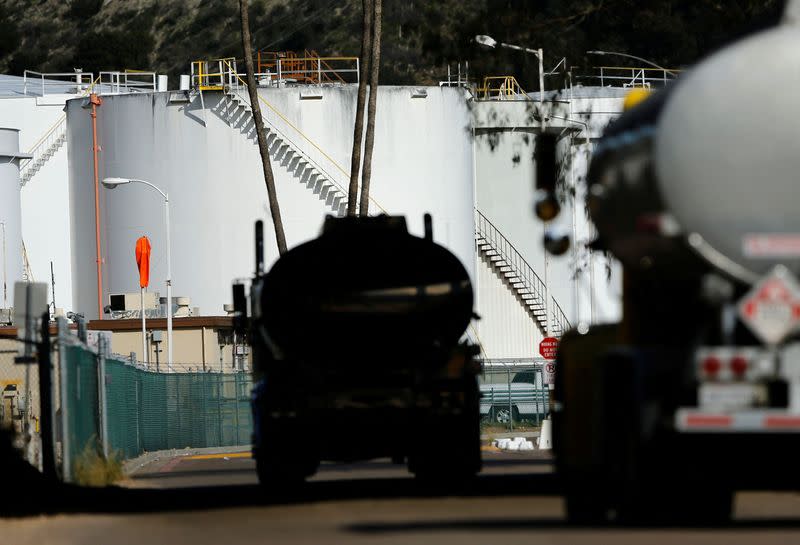Gasoline, food lift U.S. producer prices in February

By Lucia Mutikani
WASHINGTON (Reuters) - U.S. producer prices increased solidly in February as the cost of goods like gasoline surged, and further gains are in the pipeline following Russia's war against Ukraine, which has made crude oil and other commodities more expensive.
The report from the Labor Department on Tuesday offered more evidence that inflation would remain uncomfortably high in the months ahead, despite underlying price pressures at the factory gate rising moderately last month.
The Federal Reserve is expected to raise interest rates on Wednesday for the first in just over three years, with inflation running way above the U.S. central bank's 2% target. Economists are forecasting as many as seven rate hikes this year.
"We expect March PPI to show larger increases as commodity prices increase and global trade disruptions amplify," said Will Compernolle, a senior economist at FHN Financial in New York. "For consumer prices to slow, firms will first have to grapple with disruptions from the Russian invasion and new lockdowns in the heart of China's most productive regions."
The producer price index for final demand increased 0.8% after accelerating 1.2% in January. Goods prices shot up 2.4%, the largest gain since December 2009, after rising 1.5% in January. A 14.8% jump in wholesale gasoline prices accounted for nearly 40% of the increase in goods prices. Gasoline prices rose 3.3% in January. Food prices advanced 1.9% last month.
Services were unchanged after increasing 1.0% in January.
The PPI climbed 10% in the 12 months through February, matching the gain in January. Last month's increase in the PPI was in line with economists' expectations. The data does not capture the jump in prices of oil and other commodities, like wheat, following Russia's invasion of Ukraine on Feb. 24.
Stocks on Wall Street were trading higher as oil prices retreated to below $100 a barrel after Russia said it was in favor of the 2015 Iran nuclear deal resuming as soon as possible. Crude oil prices shot up more than 30%, with global benchmark Brent hitting a 14-year high of $139 a barrel, in the aftermath of Russia's invasion of Ukraine.
The dollar dipped against a basket of currencies. U.S. Treasury prices were largely trading higher.
SENTIMENT TAKES A HIT
Higher oil prices and the Russia-Ukraine war weighed on business sentiment in New York state. In a separate report on Tuesday, the New York Fed said its general business conditions index slumped 14.9 points to -11.8 in March, the weakest reading since May 2020. A reading below zero indicates a contraction in factory activity in the state.
Manufacturers reported a contraction in new orders and shipments, but continued to pay higher prices for inputs as well as charge more for their finished goods.
"Geopolitical uncertainty likely bears much of the blame," said Adam Kamins, an economist at Moody's Analytics in West Chester, Pennsylvania. "Many firms are sitting tight, either because their customers are doing so or in order to gauge the economic ramifications of the invasion."
Despite the pullback in oil prices, inflation is likely to remain hot as a resurgence in COVID-19 infections in China, a major source of raw materials for U.S. factories, puts more pressure on supply chains. Inflation was already a problem before the Russia-Ukraine war.
The government last week reported an acceleration in consumer prices in February, with the annual inflation rate posting its largest increase in 40 years.
High inflation, mostly in the form of more expensive gasoline, has prompted economists to trim their economic growth estimates for this year. So far, a recession is not anticipated as households accumulated massive savings during the pandemic.
Excluding the volatile food, energy and trade services components, producer prices climbed 0.2% in February, the smallest gain since November 2020. The so-called core PPI increased 0.8% in January. It was last month held back by a 4.2% decline in portfolio management fees as investors dumped equities in favor of the dollar and U.S. Treasuries.
There were also decreases in the prices of hotel and motel rooms as well as apparel, jewelry, footwear, and accessories retailing. That offset a 1.9% rise in the cost of transportation and warehousing services. Airline fares rebounded 3.0%, while healthcare costs rose moderately.
In the 12 months through February, the core PPI increased 6.6% after gaining 6.8% in January.
With the CPI and PPI data in hand, economists are estimating that the core personal consumption expenditures (PCE) price index rose 0.4% in February after gaining 0.5% in January.
That would lead to an annual increase of 5.5% in the core PCE price index, which advanced 5.2% on a year-on-year basis in January. It is one of the key inflation measures watched by Fed officials.
"This is consistent with the idea that underlying inflation is running at or above 5%," said Andrew Hollenhorst, chief U.S. economist at Citigroup in New York.
(Reporting by Lucia Mutikani; Editing by Nick Zieminski and Paul Simao)